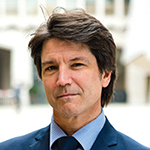Asset pooling implementation gathers momentum

|
Written By: Matthew Craig |
Matthew Craig discovers how some pension fund managers are approaching the complex tasks involved in their move towards the new pooling arrangements
Moving from 90-odd local authority pension funds into eight new asset pooling arrangements is a complex and challenging task. While getting the investment side right is obviously very important for each asset pool, so too are issues such as governance, team-building and creating the right shared values and a culture.
One way to consider how asset pooling will work is to imagine what a successful pool might look like. So, what kind of team should an asset pool aim to be? For Brunel Pension Partnership chief executive officer, Dawn Turner, the answer is to achieve the standard and discipline of an Olympic 400 metres relay team. Turner explained: “The 400 metres rather than the 100 metres as the journey is not short, and my goodness have we needed stamina! The handing over of the baton has to be as smooth as possible to be efficient, and that is about clear vision, signalling and communication. Finally, you still need the best team you can have, working hard and training constantly, both individually and together to gain the ultimate medal.”
Local Pensions Partnership chief executive, Susan Martin, can also bring out an apt sporting analogy for asset pooling, in her case, gymnastics. “We are like a gymnastics team, because gymnastics is about bringing together balance, agility, real strength and flexibility.” LPP was one of the first pools to come into existence and Martin said it was important to address the new organisation’s culture and values from the start. “At LPP, we were very clear that we wanted to respect our public sector heritage but we are operating in the private sector space, so we have to marry those two things together. And out of that, we are developing our own culture and approach. Collaboration is one of our key values as we are partnering with other organisations, our shareholders and our clients. Being a partner is part of who we are, not just a name.”
Interestingly, William Bourne, principal of Linchpin Advisory and an adviser to Nottinghamshire and East Sussex pension funds, named collaboration as a key part of the culture of the LGPS as whole, but questions if it will survive in a world of fewer, larger asset pools. “The culture of the LGPS as a whole is very collaborative. At the moment pools are still very collaborative and are helping each other. Will that carry on forever, particularly if they are competing for good staff?” Bourne said.
Martin added that learning is another key value for LPP. “When we started in 2014, there was no-one else to learn from and our advisers hadn’t done this either, so we were all learning together. We all make mistakes but you can learn from that. We were very keen to set up an organisation with collaboration, partnership and learning as key values right from the start.”
Brunel’s Turner said that each LGPS pool has found its own way to unify its chosen pension funds to create an asset pool. She explained: “At Brunel, this began with bringing together like-minded funds with similar values underpinning their considerations guiding investment decisions. From this strong beginning, the vision of Brunel was formed. In 2016, the 10 pension funds agreed 12 investment principles which have remained constant alongside the like-minded principles of being equitable and fair and working together in a true partnership approach. I think it’s the development of that strong partnership that binds us well together, building up trust and continued respect whether you’re in the pension fund or Brunel company.”
Just as the local authority funds that formed the Brunel pool share certain values, so do the LPP’s main partners, Lancashire County Council Pension Fund and the London Pensions Fund Authority (LPFA), Martin said, as both funds had experience of working with others in investment and administration. This shared background has helped with the fact that LPP is managing 100% of the assets of the pool members from day one. “It is really important to have that shared experience of delegation and both have understanding of that approach, and who does what.” Martin’s own background, as someone who worked in mergers and acquisitions and also in setting up new businesses, has helped LPP. In order to establish the right culture and values from the start, LPP organised for the senior managers at the LGPS funds to get together and share their views on the culture of high-performing businesses. “We had a day’s workshop on what the asset pool should look like, feel like and sound like about a year before we launched. We then had another senior manager group get together six months before we launched, when everyone shared what their work streams were working on, and just before we launched, we had another workshop. The senior managers meet twice a year, and information is cascaded all through the teams,” Martin said.
Turner said that Brunel’s board set out its values and purpose early on in July 2017 as soon as the pool became “real”, in a way that is simple to share and would resonate with its shareholder funds. Turner commented: “We believe in long-term sustainable investments supported by robust and transparent process; we are here to protect the interests of our clients and their beneficiary members; and in collaboration with all our stakeholders, we are forging better futures by investing for a world worth living in.” Even allowing for the common value and culture at Brunel’s underlying funds, Turner said it still took six months to agree the investment principles. “On so fundamental a building block, it’s important that there is buy-in and understanding,” she said.
Having its investment principles in established collaboration with the 10 shareholder client funds, helped Brunel set up the right investment funds. “Having the principles in place really helped us to agree a clear set of outcome-focused portfolios that all clients could map their asset allocations to and still remain true to their investment strategy statements,” Turner commented.
At LPP, Martin said that its particular heritage means its focus is on providing services for its clients on asset management, risk services and administration. “On the asset and risk side, we engage in a number of ways including investment forums and workshops for our clients. On the risk side, we want to help them understand what risks they face, and the size of their liabilities, and understanding their cash flows.” Martin added: “We are clear on the purpose of the LPP; it is about adding value, not necessarily about low costs.” This means providing a range of services to LPP’s partners to help them be more efficient, while the underlying funds retain responsibility for issues such as strategic asset allocation.
Looking at asset pooling from the outside, some see potential for conflict in the future. Bourne commented: “There is an inherent conflict for funds as the owners of the pools but also their clients. What happens when something goes wrong and a fund, or more than one fund, says a pool is not delivering the services the funds need? In theory, the funds should get together in order to change either the pool’s management or how it operates, but that will be difficult if there are lot of funds with different views.” PAAMCO vice-chairman, Stephen Oxley, said: “The relationship between the pool’s management and the underlying schemes is crucial and will vary. In the structures that we are seeing emerging, there is clearly quite a lot of responsibility still with the individual schemes. This could lead to tension between the two, with the individual scheme boards wanting to keep some control on decision-making.”
If the asset pools are to succeed, then just as successful sports teams, they need to produce good results. So far, they have made a good start in most cases. Bourne said: “Given the time constraints, the LGPS funds have done a phenomenal job of setting up the pools, but that doesn’t guarantee success in the long term and that’s what really matters.”
Like LPP’s Martin, Oxley does not see success for asset pools simply in cost terms, but in their overall performance. He commented: “It will be some time before the benefits of pooling come through. When the pools have incurred their set-up costs and are up and running, they will need to have more efficient investment – not just cheaper investment in passive assets, but actively and efficiently investing in a wider range of assets, to create better portfolios.”
More Related Content...
|
|
|


